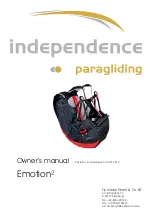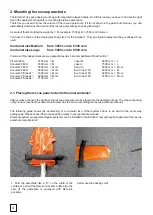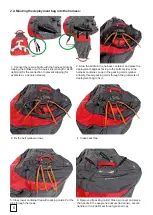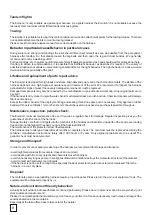
3. Fix the belt (yellow arrow).
2. Stow the bridle in the harness container and place the
deployment bag(lines facing to the bottom side) in the
harness container. Loop in the packing cords (yellow
arrows), thread packing cords through the grommets of
deployment bag to fix it.
2.2. Mouting the deployment bag into the harness:
1. Connect the rescue bridle with the harness bridle by
looping the bridles or with a quick link (strength > 2400
daN) and fix the connection to prevent slipping (for
example by a neopren sleeve).
4. Close back flap.
5. Close lower container flap with packing cords. Put the
pins through the loops.
6. Remove all packing cords! Close pin cover and place
the handle in the neoprene pockets (red arrow), secure
handle with a 2 daN seal threat (green arrow).
6
2)
3)
How to secure the release handle:
To avoid an unintentional opening it is obligatory to use a seal thread in the opening mechanism. This defines a minimum
opening force. This special thread must be put through the loop at the release handle and harness and has to be fixed by
a knot. (See picture 6 green arrow)
To secure the pin it is only allowed to use certified material because if the strength of this material is too high the save
operation of the rescue system is not guaranteed.
This thread is supplied by Flymarket GmbH & Co. KG! Do
not use
other threads which may look the same!
Attention:
After every installation of a rescue-system in a harness there must be a test if the opening force is between 2 and 7 daN. If
harness and rescue parachute are combined the first time a compatibility check have to be performed by an authorized
person!
The compatibility must be confirmed in the parachute repack log book.
Operating notes:
Conversion from harness to rucksack:
The Emotion² is a so called reversible harness. That means it can be transformed to a rucksack.
To convert the harness to a rucksack you have to open the zipper of the storage bag completely. Then the seat-
board can be turned upwards and the storage-bag can be turned inside out now. A rucksack is formed now, which
contains the harness part and offers enough space for a paraglider as well. Further equipment can be attached to
the outer side of the rucksack.
The conversion of the packsack to the harness is done vice versa.
Operation of the protector:
The Emotion² has a type certified back protector which is filled by the airstream during the flight.
During a hard landing the air inside of the protector will be compressed and the air will be deflated through the seams of
the nylon fabric. The resulting deceleration distributes the impact energy over a longer period and protects the spine from
extreme peak loads. The G-forces achieved in the type certification were very good. However, even the best back
protection does not guarantee the prevention of back injuries!!!
For this reason, the protector should not be used for unnecessary seat board landings. With every use the protector will
be less efficient and the effect of protection less - even if no damage is visible.
If a damage is visible the protector is not to be used anymore as well as after a hard landing!! In this case the harness
must be inspected by the manufacturer or an authorized dealer/workshop.
Before use of the harness the following points should be checked:
!
Outer shell of the protector and the entire belt system intact?
!
Air intake valve of protector intact and working, storage bag zipper fully closed?
!
Rescue container and release handle properly closed and mounted?
!
Acceleration system (if mounted) properly mounted and adjusted?
!
All harness buckles properly closed and adjusted?
Maintenance / service life of the protector:
The protector is almost maintenance free. Before each take off the protector should be checked for function (damages,
air intake valve working).
Visible damage (holes, cracks) must be repaired, otherwise the outer shell can break during an impact with a loss of
damping.
After a hard landing with the use of the protector and if a damage is visible the protector must be repaired or exchanged
by the manufacturer or an authorised dealer/workshop.
7


























